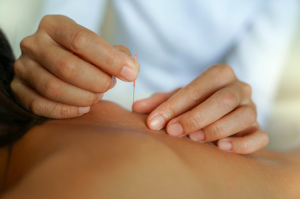
Thin acupuncture needles inserted into soft tissue
What Is Dry Needling?
Dry needling is a safe and quick treatment used by professionals such as Remedial Massage Therapists and Physiotherapists to support their traditional approaches.
It is not Acupuncture which works on energy lines in the body, the practice works on the soft tissue of the body.
Very fine needles (which are used in acupunture) are inserted into the muscles to relieve areas of hyper-irritability known as myofascial trigger points (TP’s). These troublesome areas can be palpated as nodules within taut bands of muscle fibres.
Trigger Point Therapy can be applied using the hands but the precision gained using the needles makes the technique even more effective.
The development of trigger points in the muscles is very common and can be caused by a combination of over-use/repetitive strain, poor posture and bio-mechanics, soft tissue/joint injury and is exacerbated by chronic stress, poor sleep and poor recovery. It is not the preserve of athletes and sports people. Office workers who spend long hours at the desk and people who drive for a living as well as those with very physical jobs all develop theses painful points in their bodies.
Why is it important to have trigger points worked out?
Trigger points (TP’s) are painful; they are hyper-sensitive to touch and pressure and when left unattended create what we call referral pathways where pain travels or ‘pops up’ in areas remote from the site of the TP. This means, for example, that the therapist may apply pressure to a spot around the client’s shoulders and a blinding pain may travel to their temple. They then make the connection that their recent cause of headache actually arises from muscular tension in the shoulders.
Furthermore, when muscles are sore and plagued by TP’s they cannot work properly, they are weakened and ineffective. A whole pattern of compensation is set up whereby other structures take the load to allow the body/the individual to do what they need to do in their life.
This system of compensation can only go on for so long before the person begins to notice pain or discomfort throughout the body, loss of mobility in the joints, hyper (too much) mobility in other joints, loss of strength and performance and ultimately breakdown of the system and injury.
When this happens we have one unhappy and frustrated client.
How does dry needling work?
In basic terms the needles work by creating a twitch response in the muscles and these erratic contractions help to break the hold in the muscle fibres. When inserted into the ‘sweet spot’ of the TP the client will perceive it immediately and a rush of adrenalin will momentarily be experienced. This floods the area with natural painkillers. Furthermore, the insertion of the needles also causes the blood vessels in the area to dilate allowing fresh blood to flush the area.
Finally the muscle can ‘breath’ again and get rid of the chemical soup which has been trapped; the cause of that burning/aching sensation! Massage and manipulation of the muscles after needling helps to restore balance to the body.
Glasgow Dry Needling Service Coming Soon
The use of dry needling alongside massage therapy is a very complimentary way to relax the tissues of the body and more systemically, the client, to identify areas of hypertension, then deploying the needles to pin point the trigger points and effectively eradicate them.
The therapeutic benefits of combining dry needling with massage therapy extend across a spectrum of conditions, offering a comprehensive approach to pain management and recovery. Testimonials and case studies further illustrate the impact of these treatments across a range of conditions. Patients report not only a significant reduction in pain and improvement in mobility but also an enhanced ability to engage in daily activities, contributing to greater quality of life.
This combined treatment is coming soon to Restoring Balance Massage!

